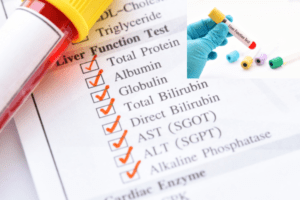Lipoprotein (a) and nonalcoholic fatty liver disease have a linear negative correlation.
Overview
Due to metabolic abnormalities, millions of people worldwide suffer from nonalcoholic fatty liver disease (NAFLD), one of the most common liver ailments. In the meanwhile, cardiovascular disorders have long been linked to lipoprotein (a), or Lp(a). According to recent research, Lp(a) levels and the onset of NAFLD are linearly correlated negatively. However, what does this signify? What is the relationship between these two biological factors? In order to clarify their conflicting functions in liver and metabolic health, this article examines the scientific relationship between Lp(a) and NAFLD.

Lipoprotein (a): What is it?
1. Knowing Lp(a) and How It Works
Apolipoprotein (a) is a component of lipoprotein (a), a distinct particle that resembles low-density lipoprotein (LDL). It is inherited and associated with cardiovascular diseases (CVDs) and atherosclerosis.
Elevated levels of Lp(a) are regarded as a stand-alone risk factor for heart disease.
The liver is where it is mostly manufactured.
Lp(a) has a more intricate function in inflammation and lipid metabolism than LDL.
2. Lp(a)’s Function in Metabolic Disorders
Despite being a well-known cardiovascular risk factor, Lp(a) has a surprisingly inverse impact on metabolic diseases like NAFLD. Higher Lp(a) levels have been linked to a decreased incidence of NAFLD, according to studies.
Comprehending NAFLD (nonalcoholic fatty liver disease)

1. First, what is NAFLD?
NAFLD is a disorder in which people who drink little or no alcohol accumulate too much fat in their liver. It consists of:
A deposit of fat without inflammation is called simple steatosis.
Nonalcoholic Steatohepatitis (NASH): Inflammation and fat accumulation that results in cirrhosis and fibrosis.
2. NAFLD Risk Factors
Insulin resistance in obesity
Diabetes mellitus type 2 (T2DM)
Abnormal lipid levels, or dyslipidemia
The metabolic syndrome and hypertension
3. The Increasing Number of NAFLD Cases
NAFLD is becoming more prevalent globally due to sedentary lifestyles and bad eating habits, which makes it a serious health issue.
 Investigating the Negative Association Between NAFLD and Lp(a)
Investigating the Negative Association Between NAFLD and Lp(a)
1. First, what is meant by a negative correlation?
When there is a linear negative correlation, one variable falls as the other rises. In this instance, a decreased prevalence of NAFLD is linked to higher Lp(a) levels.
2. Scientific Proof That This Correlation Is True
Numerous investigations have looked into the connection between Lp(a) and NAFLD:
Clinical Trials: Studies indicate that people who have lower levels of Lp(a) are more likely to develop fatty liver.
Meta-Analyses: Comprehensive research suggests that Lp(a) may offer protection against the buildup of hepatic lipids.
Genetic Insights: Susceptibility to liver fat deposition is influenced by specific genetic variants that alter Lp(a) levels.
3. Possible Processes That Could Explain the Connection
Lipid Metabolism and Lp(a): Lipid metabolism and transport are the main functions of Lp(a). Elevated levels of Lp(a) could stop the liver from accumulating too much fat.
Anti-Inflammatory Effects: Lp(a) may contain anti-inflammatory qualities that guard against liver injury, in contrast to other LDL particles.
Hormonal and Genetic Influences: Hepatic lipid homeostasis and genetic regulation of Lp(a) levels may cooperate to prevent the buildup of fat in the liver.
Why Is NAFLD Prevented by Lp(a)?
1. Apolipoprotein’s Function (a)
Hepatic lipid uptake may be hampered by apolipoprotein (a), a crucial part of Lp(a).
By influencing lipoprotein metabolism, it lessens the liver’s buildup of triglycerides.
2. Insulin Sensitivity and Lp(a)
Better insulin sensitivity, which lowers liver fat accumulation, is correlated with higher Lp(a) levels.
The development of NAFLD is significantly influenced by insulin resistance.
3. Individual Variations and Genetic Predisposition
Since Lp(a) levels are mostly genetically determined, genetic factors affect the risk of both Lp(a) and NAFLD.
People with naturally elevated Lp(a) levels might have metabolic responses that protect them from NAFLD.
Clinical Consequences: What Patients Should Know
Is It Appropriate to Use Lp(a) as a NAFLD Biomarker?
Lp(a) levels may function as a predictive biomarker for NAFLD risk assessment due to the inverse connection.
Before Lp(a) screening is incorporated into standard liver disease diagnosis, more study is required.
2. How Can This Aid in the Management of NAFLD?
New targeted treatments for NAFLD may result from an understanding of this association.
Drugs that affect the metabolism of Lp(a) may be investigated to avoid liver damage.
3. Is It Reason to Worry About Patients With High Lp(a)?
Cardiovascular risks are still closely associated with elevated Lp(a) levels.
Although it might lower the risk of NAFLD, heart disease treatment is still necessary.
In conclusion
Conventional wisdom regarding lipoprotein metabolism and liver disease is called into question by the linear negative connection shown between Lp(a) and NAFLD. Higher Lp(a) levels still carry the risk of cardiovascular diseases even though they seem to guard against fatty liver. New diagnostic indicators and approaches to treating heart disease and non-alcoholic fatty liver disease may be made possible by an understanding of this intricate link.
FAQs
1. Can NAFLD be totally prevented by elevated Lp(a) levels?
No, although they do not totally prevent it, high Lp(a) levels are linked to a decreased risk of NAFLD. Other factors also come into play, such as lifestyle, heredity, and diet.
2. Does reducing Lp(a) raise the risk of NAFLD?
Although there is no concrete proof that lowering Lp(a) raises the risk of NAFLD, research indicates that people who naturally have low Lp(a) levels may be more likely to develop fatty liver.
3. How can my Lp(a) levels be checked?
Lp(a) levels can be measured with a straightforward blood test. For those who are at risk of cardiovascular illnesses, it is advised.
4. Can liver health be affected by Lp(a)-lowering treatments?
Although therapies such as PCSK9 inhibitors can reduce Lp(a), research is still ongoing to determine how they affect NAFLD. Any direct influence on the buildup of liver fat requires more investigation.
5. In order to prevent NAFLD, should I concentrate on raising my Lp(a)?
No, having a high Lp(a) still increases your chance of developing heart disease. Maintaining general metabolic health should be the aim instead of modifying Lp(a) levels artificially.


1 thought on “Lipoprotein (a) and nonalcoholic fatty liver disease have a linear negative correlation.”